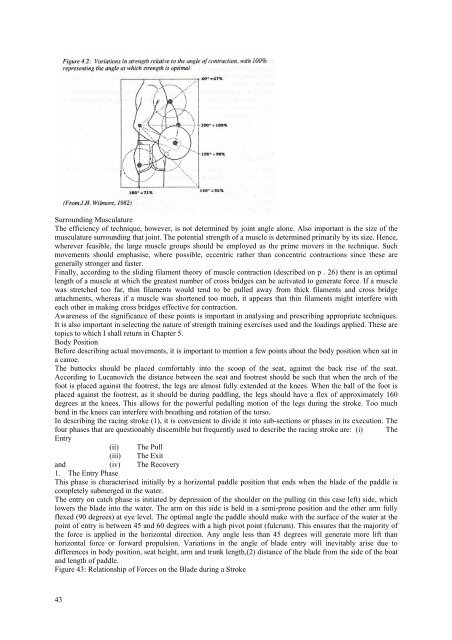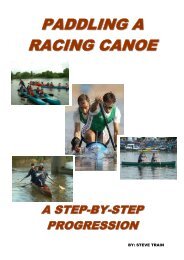The Science of Canoeing By Richard Cox
The Science of Canoeing By Richard Cox
The Science of Canoeing By Richard Cox
You also want an ePaper? Increase the reach of your titles
YUMPU automatically turns print PDFs into web optimized ePapers that Google loves.
Surrounding Musculature<br />
<strong>The</strong> efficiency <strong>of</strong> technique, however, is not determined by joint angle alone. Also important is the size <strong>of</strong> the<br />
musculature surrounding that joint. <strong>The</strong> potential strength <strong>of</strong> a muscle is determined primarily by its size. Hence,<br />
wherever feasible, the large muscle groups should be employed as the prime movers in the technique. Such<br />
movements should emphasise, where possible, eccentric rather than concentric contractions since these are<br />
generally stronger and faster.<br />
Finally, according to the sliding filament theory <strong>of</strong> muscle contraction (described on p . 26) there is an optimal<br />
length <strong>of</strong> a muscle at which the greatest number <strong>of</strong> cross bridges can be activated to generate force. If a muscle<br />
was stretched too far, thin filaments would tend to be pulled away from thick filaments and cross bridge<br />
attachments, whereas if a muscle was shortened too much, it appears that thin filaments might interfere with<br />
each other in making cross bridges effective for contraction.<br />
Awareness <strong>of</strong> the significance <strong>of</strong> these points is important in analysing and prescribing appropriate techniques.<br />
It is also important in selecting the nature <strong>of</strong> strength training exercises used and the loadings applied. <strong>The</strong>se are<br />
topics to which I shall return in Chapter 5.<br />
Body Position<br />
Before describing actual movements, it is important to mention a few points about the body position when sat in<br />
a canoe.<br />
<strong>The</strong> buttocks should be placed comfortably into the scoop <strong>of</strong> the seat, against the back rise <strong>of</strong> the seat.<br />
According to Lucanovich the distance between the seat and footrest should be such that when the arch <strong>of</strong> the<br />
foot is placed against the footrest, the legs are almost fully extended at the knees. When the ball <strong>of</strong> the foot is<br />
placed against the footrest, as it should be during paddling, the legs should have a flex <strong>of</strong> approximately 160<br />
degrees at the knees. This allows for the powerful pedalling motion <strong>of</strong> the legs during the stroke. Too much<br />
bend in the knees can interfere with breathing and rotation <strong>of</strong> the torso.<br />
In describing the racing stroke (1), it is convenient to divide it into sub-sections or phases in its execution. <strong>The</strong><br />
four phases that are questionably discernible but frequently used to describe the racing stroke are: (i) <strong>The</strong><br />
Entry<br />
(ii) <strong>The</strong> Pull<br />
(iii) <strong>The</strong> Exit<br />
and (iv) <strong>The</strong> Recovery<br />
1. <strong>The</strong> Entry Phase<br />
This phase is characterised initially by a horizontal paddle position that ends when the blade <strong>of</strong> the paddle is<br />
completely submerged in the water.<br />
<strong>The</strong> entry on catch phase is initiated by depression <strong>of</strong> the shoulder on the pulling (in this case left) side, which<br />
lowers the blade into the water. <strong>The</strong> arm on this side is held in a semi-prone position and the other arm fully<br />
flexed (90 degrees) at eye level. <strong>The</strong> optimal angle the paddle should make with the surface <strong>of</strong> the water at the<br />
point <strong>of</strong> entry is between 45 and 60 degrees with a high pivot point (fulcrum). This ensures that the majority <strong>of</strong><br />
the force is applied in the horizontal direction. Any angle less than 45 degrees will generate more lift than<br />
horizontal force or forward propulsion. Variations in the angle <strong>of</strong> blade entry will inevitably arise due to<br />
differences in body position, seat height, arm and trunk length,(2) distance <strong>of</strong> the blade from the side <strong>of</strong> the boat<br />
and length <strong>of</strong> paddle.<br />
Figure 43: Relationship <strong>of</strong> Forces on the Blade during a Stroke<br />
43



